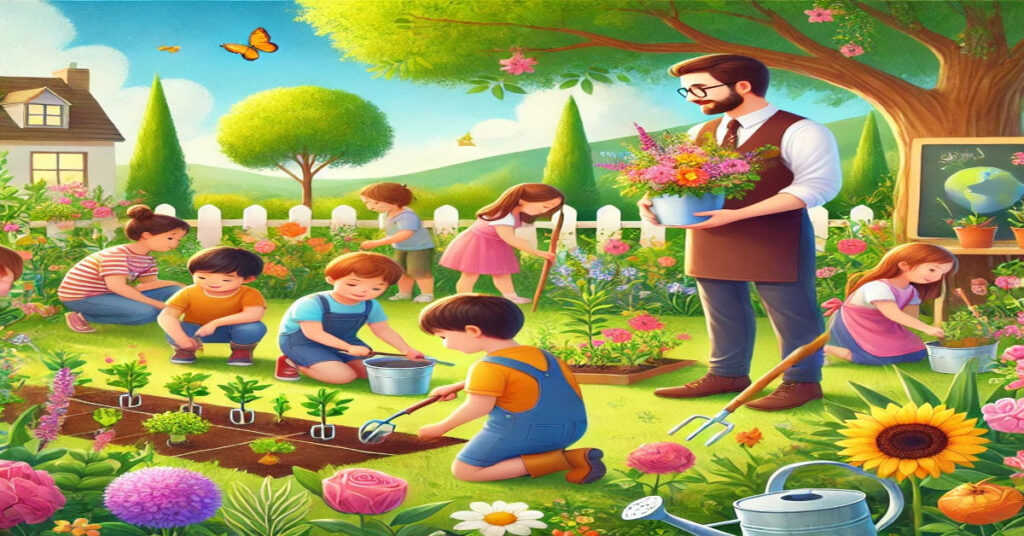Gardening is more than just a hobby it’s a way to connect with nature, learn responsibility and foster creativity. When it comes to children, gardening takes on a whole new dimension. Kinder gardening, or gardening with kids, is a growing trend that combines education, fun, and environmental awareness. It’s not just about planting seeds; it’s about planting ideas, curiosity, and a love for the natural world.
In recent years, programs like ASAP’s Growing Minds have been instrumental in promoting school gardens, especially in regions like Western North Carolina. With support from organizations like Roots Organic Gourmet, these initiatives are helping schools create vibrant garden spaces where children can learn, grow, and thrive. As spring brings gardens to life, the stories and photos from these programs are a testament to the magic of kinder gardening.
Let’s dig deeper into the world of kinder gardening, exploring its benefits, tips to get started, and how it’s shaping the future of education and sustainability.
What is Kinder Gardening?
Kinder gardening is the practice of involving children in gardening activities, whether at home, in schools, or community spaces. It’s not just about growing plants; it’s about nurturing young minds. Through hands-on experiences, kids learn about nature, science, and the environment while developing essential life skills.
This concept goes beyond traditional gardening by making it accessible, engaging, and educational for children. It’s about creating a space where kids can explore, ask questions, and discover the wonders of the natural world.
Why Kinder Gardening Matters
1. Encourages Environmental Stewardship
Kinder gardening teaches children the importance of caring for the planet. By growing their own plants, kids learn about ecosystems, sustainability, and the role they play in protecting the environment.
2. Promotes Healthy Eating Habits
When children grow their own fruits and vegetables, they’re more likely to try and enjoy them. Gardening introduces kids to fresh, healthy foods and encourages better eating habits.
3. Boosts Physical and Mental Well-being
Gardening is a great way to get kids outdoors and active. It also reduces stress, improves focus, and fosters a sense of accomplishment.
4. Enhances Learning and Creativity
Gardening is a hands-on way to teach science, math, and even art. It sparks curiosity and creativity, making learning fun and interactive.
How to Start a Kinder Garden
Starting a kinder garden doesn’t require a lot of space or resources. Here’s how you can create a garden that’s perfect for kids:
1. Choose the Right Location
Pick a spot that gets plenty of sunlight and is easily accessible for children. It could be a small patch in your backyard, a schoolyard, or even a few pots on a balcony.
2. Select Kid-Friendly Plants
Opt for plants that are easy to grow and maintain. Some great options include sunflowers, cherry tomatoes, carrots, and herbs like mint or basil.
3. Make It Fun and Interactive
Incorporate fun elements like colorful signs, fairy gardens, or DIY plant markers. Let kids personalize their garden space to make it their own.
4. Teach Through Activities
Turn gardening into a learning experience. Teach kids about the life cycle of plants, the importance of pollinators, and how to compost.
5. Be Patient and Encouraging
Gardening is a process, and not everything will go as planned. Encourage kids to keep trying and celebrate their successes, no matter how small.
Success Stories: Kinder Gardening in Action
Programs like ASAP’s Growing Minds are making a big impact by bringing gardens into schools. With funding from organizations like Roots Organic Gourmet, schools in Western North Carolina have been able to create thriving garden spaces.
Teachers report that these gardens are not just teaching kids about plants but also fostering teamwork, responsibility, and a love for nature. As spring arrives, the gardens are flourishing, and so are the children who tend to them.
Tips for Parents and Educators
1. Start Small
You don’t need a huge garden to get started. Even a few pots or a small raised bed can be a great way to introduce kids to gardening.
2. Involve Kids in Every Step
From planning to planting to harvesting, let kids be involved in every stage of the gardening process.
3. Use Gardening as a Teaching Tool
Incorporate lessons about science, math, and even history into your gardening activities.
4. Celebrate the Harvest
When it’s time to harvest, celebrate the fruits (and vegetables) of your labor. Cook a meal together or share your produce with friends and family.
The Future of Kinder Gardening
As more schools and communities embrace kinder gardening, the benefits are becoming increasingly clear. These gardens are not just growing plants; they’re growing future environmentalists, scientists, and leaders.
By teaching children to care for the earth, we’re sowing the seeds for a greener, healthier future. Kinder gardening is more than a trend; it’s a movement that’s changing the way we think about education and sustainability.
Conclusion
Kinder gardening is a powerful tool for teaching children about nature, responsibility and the joy of growing things. Whether it’s a school garden or a few pots on a windowsill, these small steps can have a big impact.
As we’ve seen through programs like ASAP’s Growing Minds, kinder gardening is transforming education and inspiring a new generation of gardeners. So grab some seeds, gather the kids, and start planting—your garden adventure awaits!
FAQs
1. What age is best to start kinder gardening?
Kids as young as 3 can start with simple activities like watering plants or digging. Older children can handle more complex tasks like planting and harvesting.
2. Do I need a lot of space for a kinder garden?
No, you can start with a small space, a few pots, or even a windowsill garden.
3. What are the easiest plants for kids to grow?
Sunflowers, cherry tomatoes, radishes, and herbs like basil are great starter plants for kids.
4. How can I make gardening fun for kids?
Add creative elements like fairy gardens, colorful signs, or DIY plant markers to make gardening more engaging.
5. Can kinder gardening be done indoors?
Yes, you can grow herbs, microgreens, or small vegetables indoors with proper light and care.
6. How does kinder gardening benefit education?
It teaches science, math, and environmental awareness in a hands-on, interactive way.
7. What tools do kids need for gardening?
Child-sized gloves, trowels, and watering cans are perfect for little hands.
8. How do I keep kids interested in gardening?
Involve them in every step, celebrate their successes, and keep the activities fun and varied.
9. Can kinder gardening help picky eaters?
Yes, growing their own food often encourages kids to try new fruits and vegetables.
10. Are there any safety concerns with kinder gardening?
Use child-safe tools, avoid toxic plants, and supervise younger children to ensure a safe gardening experience.







